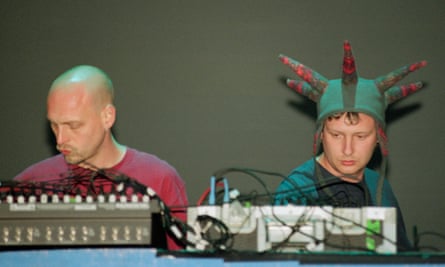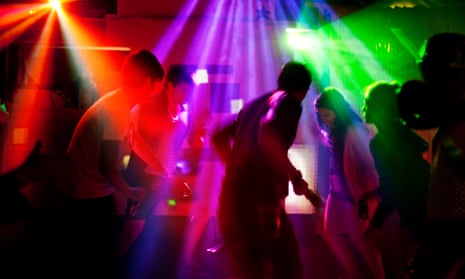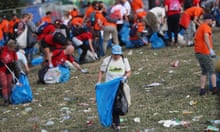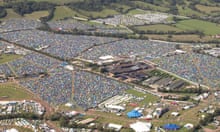Giant rubber duckies; tunnels of flowers; bassbins disguised with gingham tablecloths; sitting in upturned burning cars as entertainment. As if it weren’t enough of a struggle trying to get people to untangle their first Glastonbury raving memories from three decades ago, the things they do remember feel pretty hallucinatory on their own.
Nobody can be quite sure when raving first started in Glastonbury. Obviously all-night dancing predates acid house, but through the 80s that meant dub reggae: Youth of Killing Joke and the Orb remembers Saxon and Jah Shaka soundsystems as “the only music you could go dance to all night long that wasn’t acoustic around a bonfire”. The Mutoid Waste Company’s dystopian wreckage sculptures hosted pagan-industrial metal-banging dances throughout the night. Dance music as such wasn’t unknown, though. Mark Darby of Exeter’s Mighty Force collective says: “The first traveller soundsystem playing dance music I personally heard was Crazy Dave’s Record Bus – an old green coach with huge speakers – going through a disco phase, one afternoon at Stonehenge 83!”
It was 1989, however, when everything came together. The photographer Matt Smith was then a student, and Glastonbury was his first documentary project. “I danced almost the whole festival long,” he says with a laugh. “I remember finding this double-decker bus in the Green Fields, disguised as a cafe but the tables were speakers, playing really beautiful deep house. It was dark when I got there, and I just danced for 14 hours, watched an amazing summer sunrise and carried on well into the next day. Then I remember sneaking down the side of a stall, and finding the Sugarlump tent, absolutely rammed and heaving, acid house and crazy lights. Before I knew it, my mate Dan was halfway up the tentpole raving with one hand, clinging on with the other.”

“Sneaking down the side of a stall” was key in 1989. Though there were soundsystems like the Blim Brothers sound and a mythical rig featuring a rubber duck carousel in the travellers’ field outside the festival perimeter, the real acid house action was in the traders’ area, thanks to Sugarlump and Mindscapes. The former were a crew who’d been putting on parties in London “for acid heads to dance to mainly psychedelic funk” from the mid 80s, and gradually turned to electronic music. The latter was a stall set up by the incorrigible Peterborough-born ex-biker turned psychedelic artist turned acid house promoter Nick Mindscapes. “I had a stall to sell my paintings,” he says, “so I set up decks, speakers, a big screen to project my visuals on, got a DJ playing and didn’t stop from Thursday to Monday lunchtime.”
Sugarlump went even further. Graham Power describes it: “We had a whole marquee behind a stall, I think from Wednesday to Monday, with a huge rig. People would come in, drop their rucksacks and not leave – because there was everything they needed: music, drugs, food, and haybales to sleep on if they needed.” They were not officially welcome at the festival – “Eavis hated acid house” says Power – but were given a nod and wink by the ground staff. Indeed, Mindscapes recalls: “We blew a couple of fuses but, instead of shutting us down, the stewards got us wired into the festival power supply proper!”
Q&ACould this be Glastonbury’s greenest year yet?
Show
Glastonbury is banning single use plastics. The world’s largest greenfield festival wants to avoid scenes of the area in front of its legendary stages being strewn with plastic after the shows have ended. In 2017, visitors to the festival got through 1.3m plastic bottles.
For 2019, festival co-organiser Emily Eavis said “We’re asking people to bring a reusable bottle to the festival this year, which can be filled up from one of 37 WaterAid kiosks or 20 refill stations.”
People are also being encouraged to take other steps to limit their impact on the environment, such as using public transport to get to the venue, avoiding the use of undegradable wet wipes, not leaving their tents behind to prevent them ending up in landfill, and opting for biodegradable glitter instead of the plastic kind.
This year the festival will also feature a procession held by climate crisis activists Extinction Rebellion.
All this represented a schism in the hippy/traveller community. Helen Hatt, a prime mover in the 80s Peace Convoy, says: “We thought the party people were litter louts, we wanted the scene to be about acoustic music and being with our families, and we kind of hid away in the Green Fields. After that we had to rename our festivals things like ‘holistic holiday camps’, just to make sure the authorities didn’t think they were raves.” From the other side, Mindscapes says: “Watching the pissed folk-heads trying to get their feet round 120 beats per minutes was a whole lot of fun.”

Either way, it changed Glastonbury, the festival scene and many lives for good. By 1990 – the year of the Happy Mondays and riots in the traveller fields – there were mini-raves across the site. In 1992, Sugarlump “got given a whole field to do what we wanted in”, and renowned soundsystem designer Tony Andrews set up the Experimental Sound Field with Underworld, Orbital and others playing all weekend. Finally, in 1995, it became clear that dance music culture was a major part of the festival, and Eavis brought in Malcolm Haynes to set up the first official dance tent. Contra the idea he hated dance music, Eavis didn’t really know what it was: “He thought it was Massive Attack and Portishead!” says Haynes.
Haynes now presides over the huge Silver Hayes field, featuring multiple dance arenas, while the Arcadia and Bloc areas bring together rave culture with highly advanced versions of Mutoid Waste’s vision. Many of those who were there in 89 never stopped dancing. Matt Smith says he “went home, developed my pictures then followed the traveller convoy to Treworgey Tree Fayre” – the Cornish festival that Darby says is “where house music really hit the traveller scene” – and has been documenting subcultures, and especially free parties ever since. Power even remembers meeting a successful sound system designer recently, who had been taken by his parents into the Sugarlump tent in 1989, when he was 14. “He thought it was paradise, said to himself: ‘This is how I want to live’ … and that’s exactly what he’s done.”









Comments (…)
Sign in or create your Guardian account to join the discussion